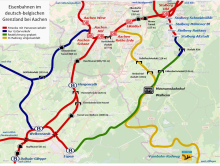Eilendorfer tunnel
| Eilendorfer tunnel | ||
|---|---|---|
|
West portal of the Eilendorfer tunnel with a Euregiobahn railcar
|
||
| use | Railway tunnel | |
| traffic connection | High-speed line from Cologne to Aachen | |
| place | Eilendorf | |
| length | 357 m | |
| Number of tubes | 1 | |
| Largest coverage | 39 m | |
| construction | ||
| start of building | July 1964 | |
| completion | February 28, 1966 | |
| business | ||
| operator | DB network | |
| release | April 4th 1966 | |
| location | ||
|
|
||
| Coordinates | ||
| East portal | 50 ° 47 '15 " N , 6 ° 10' 9" E | |
| West portal | 50 ° 47 '13 " N , 6 ° 9' 52" E | |
The Eilendorfer Tunnel is a 357-meter-long, double-track railway tunnel on the high-speed line Cologne – Aachen east of Eilendorf .
history
construction
In 1963, the Federal Railroad pursued the electrification of its main lines to increase travel speed . The electrification of the route between Cologne and Aachen was prevented by the narrow cross-sections of the tunnels, which would not meet the clearance profile after the electrical overhead line was installed . The plans for the Nirm Tunnel envisaged slitting open the tunnel , which was built in 1841 and partially damaged in the Second World War , and building two independent new tunnel structures, both of which were to be 125 meters long. The western of the two tunnels was named Eilendorfer Tunnel . A cut was to be made between the two tunnels. While the Nirmer Tunnel was built with bricks , concrete was used for the new Nirmer Tunnel and the Eilendorfer Tunnel .
However, the construction work brought with it some problems: Flowing sand was found at the west portal of the tunnel , which hindered the work using the mining method, which is why the entire tunnel construction had to be carried out in an open cut, and the embankments were not stable enough, after heavy rainfall There was a landslide on the embankment of the incision, as a consequence the embankment was made flatter and the assumed length of the Eilendorfer tunnel increased: Instead of the planned 125 meters, the Eilendorfer tunnel is now 357 meters long and thus the longest tunnel structure on the high-speed line Cologne-Aachen.
The overburden that arose when the tunnel was cut open and the deeper cover was removed was used to backfill a neighboring limestone quarry .
business
After the Eilendorfer Tunnel was opened to traffic in 1966, the Federal Railroad carried out high-speed tests in July 1967, including the E 03 series . The aim was to research the pressure behavior when trains meet in the tunnel at speeds of up to 200 km / h.
In 1982, movements of the earth in the area of the cut east of both tunnels were detected again. As a consequence, a track was temporarily swiveled and sheet pile walls were driven in. The tracks in and around the Eilendorfer Tunnel were replaced in 2012. The Eilendorfer Tunnel was designed for the planned speeds of 200 km / h during construction. The maximum speed allowed today is 130 km / h (as of 2013).
Web links
- Report with photos on the construction work on the Eilendorfer Tunnel up to 1966
- Information and pictures about the tunnel at www.eisenbahn-tunnelportale.de
Individual evidence
- ↑ a b c Demolition and construction of the Nirmer Tunnel on eisenbahn-stolberg.de , accessed on June 23, 2013.
- ↑ Cologne-Aachen high-speed railway on gessen.de , accessed June 22, 2013.
- ↑ a b High-speed test drives between Stolberg Hbf and Aachen-Rothe Erde station in July 1967 on eisenbahn-stolberg.de , accessed on June 22, 2013.
- ↑ Photo of the construction work 2012 on bahnbilder.de , accessed on June 22, 2013.


